Introduction
Public transportation plays a significant role in modern society. It is one of the primary public services that:
- Defines overall quality of life by reducing harmful pollution and providing various benefits to individuals and communities.
- Contributes to economic growth and profit sustainability by reducing traffic congestion times, increasing access to employment, lowering transportation and business costs, and improving business productivity.
- Since Dubai is one of the fastest growing urban areas in the world, it is highly dependent on public transportation, which.
- Increases the vulnerability of public transportation networks to various environmental threats.
- Requires the development of infrastructure systems that would facilitate efficient crisis management.
In the public transportation sector, crisis management efforts should focus primarily on the following areas:
- Vehicle-related accidents.
- Employee and passenger health and safety.
- Damage to transit properties.
- Insurance against terrorism and related incidents.
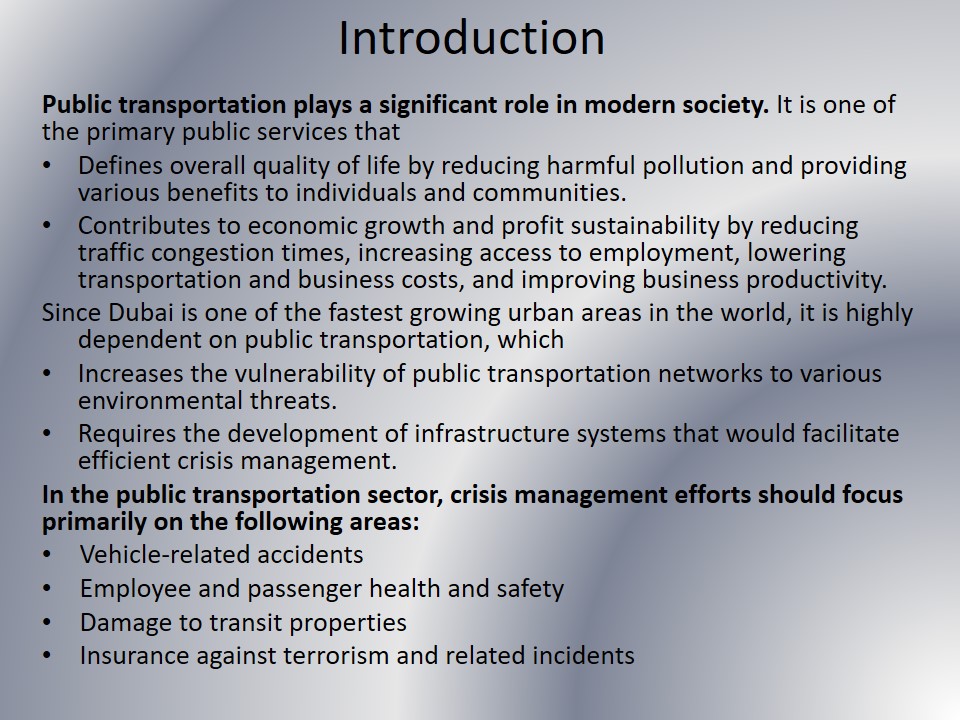
Background of the Study
- Crisisis defined as:
- A low-probability, high-impact event that often causes a threat to the viability of the organization (Paraskevas, 2006).
- A threat to basic values upheld by society, which causes a feeling of uncertainty and requires an urgent response on multiple levels (Stein, 2008).
- Adverse critical events can be distinguished by their severity, origins, and scope of effects:
- Hazard ─ a natural or human-made process inducing potential losses and disruption.
- Unsystematic hazards may affect just a particular segment or element in the system.
- Systematic hazards may affect the whole society and provoke significant disturbances.
- Disaster ─ an extremely severe hazard that has happened and affects a substantial number of people and activities.
- Catastrophe ─ a large-scale disaster inducing significant and serious damages, usually in an unexpected manner.
- Hazard ─ a natural or human-made process inducing potential losses and disruption.
- Crisis management includes four basic phases:
- Prevention;
- Preparedness;
- Response;
- Recovery.
From the stance of the crisis management communication system, the third phase, response, is the most challenging because it is the most dynamic and is associated with real-time interaction between various groups of crisis responders.
- Crisis management is meant to:
- Remove or minimize the risk of uncertainty and threat to community assets in order to let an individual or an organization achieve more control over the situation (Paraskevas, 2006).
- Identify early signs of a crisis through the implementation of a thoughtful, analytical process and a particular managerial approach that anticipates the complex nature of critical adverse events.
- Ensure the safety and welfare of all stakeholders.
- Minimize or eliminate possible crisis-associated environmental impacts and ensure an uninterrupted continuation of organizational operations and social functioning.
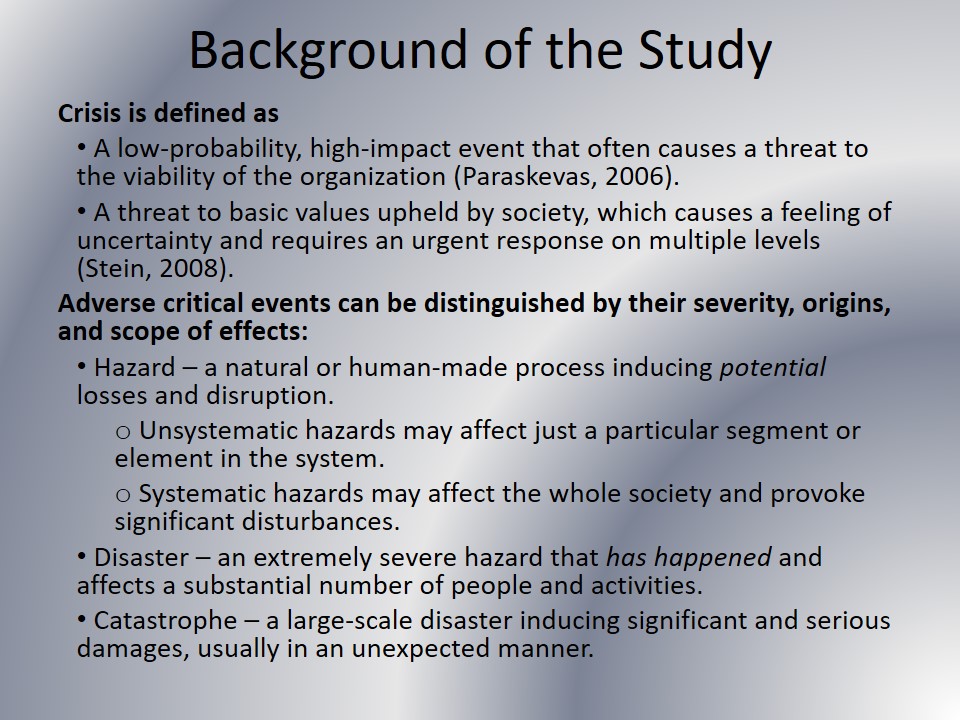

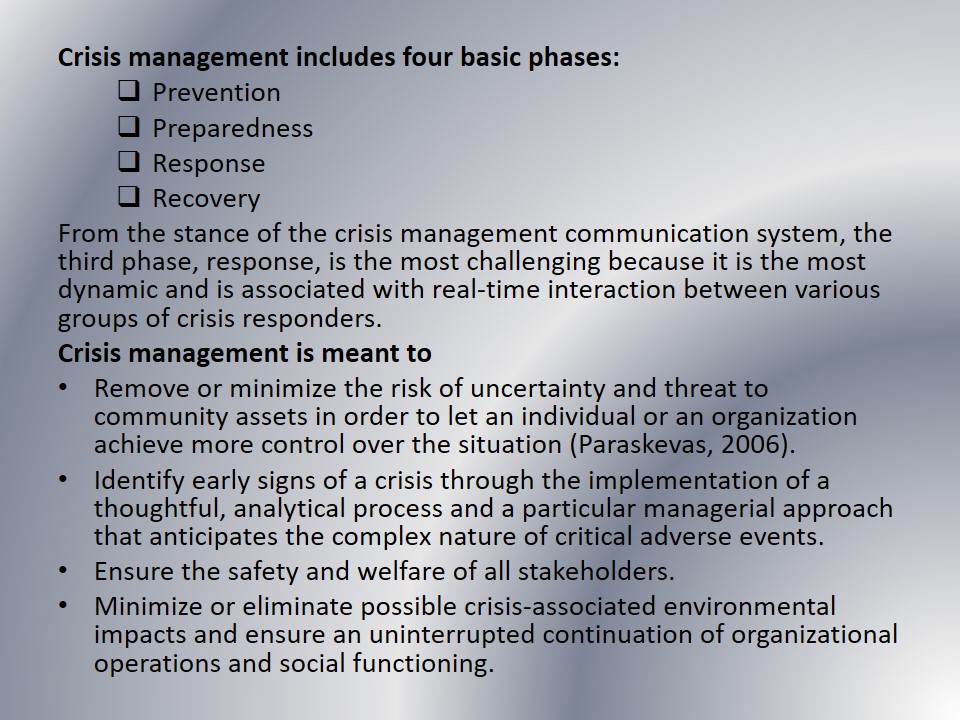
Problem Statement
Dubai’s Roads and Transport Authority (RTA) is responsible for the management of public transportation in the urban area. Specific tasks of RTA include
- Supervision of the surface public transportation: buses, tram system, taxis, and metro system.
- Road construction, control of maritime transport, and transport licensing services.
- Improvement and advancement of public transportation facilities.
Problems RTA is currently facing are related to the sector’s exposure to numerous environmental and market forces that require constant changes and foster relational complexity.
At the present moment, the operations and crisis management of Dubai’s RTA are associated with multiple drawbacks:
- Operations can be completely interrupted within a station/stop area, a route line, or a section of a route.
- The route is often difficult to pass due to an accident or a failure in the existing systems.
- It is necessary to pass a station or a stop without being able to prevent passengers from exiting and boarding.
- These conditions make it impossible to ensure the environment needed for effective operation of various means of transportation in case of terrorist attacks or natural disasters.
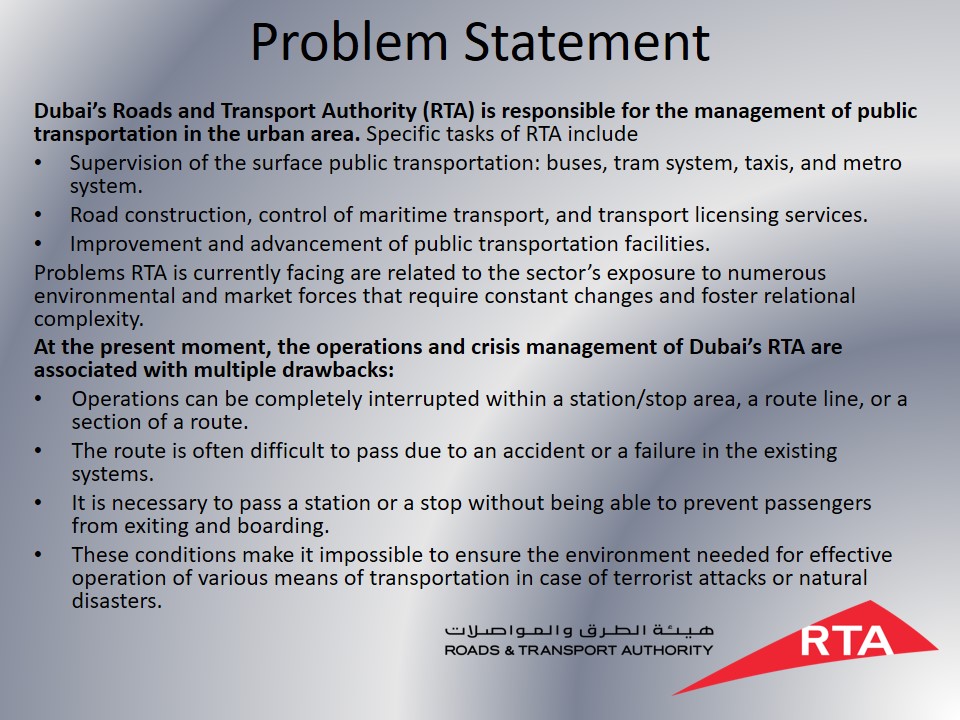
Research Aim and Objectives
- Research aim:
- To evaluate the critical factors affecting crisis management in public transportation and decisions regarding crisis prevention in a strategic context.
- Research objectives:
- To analyze crisis-related issues in the area of public transportation, including major challenges and barriers to effective management.
- To identify primary theoretical frameworks that may help build a valid and highly efficient crisis management strategy.
- To investigate the main factors supporting strategies for crisis management in public transportation by using empirical research methods.
- To outline the practical and theoretical implications of the study’s findings in order to identify possible new contributions to the research on the selected topic, and demonstrate the factors that should be considered to ensure the effectiveness of crisis management to actors in the public transportation sector.
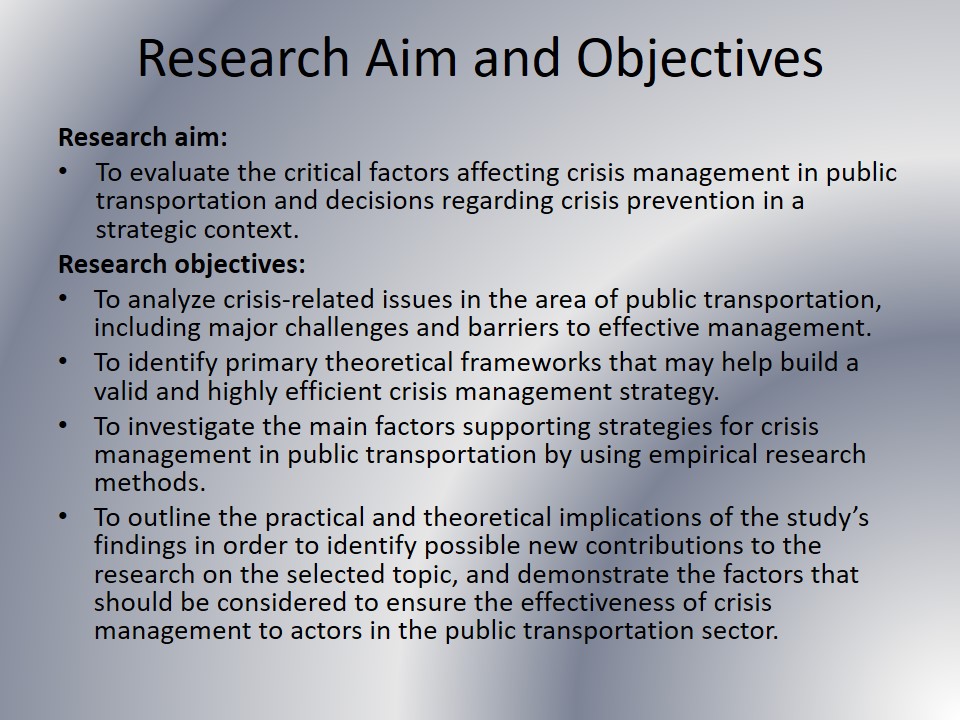
Research Questions
- Q1 Factors of crisis management:
- What factors contribute to the successful implementation of crisis management models?
- How do these factors affect crisis management strategy implementation and practice?
- What strategic steps, actions, and best practices should be applied in order to achieve successful crisis management?
- What are the major barriers to the development of a crisis management strategy?
- Q2 Crisis management in public transportation:
- How does crisis management practice support the incorporation of the identified factors in the process of strategic planning?
- How can it foster improvement of the crisis management system in the public transportation sector?
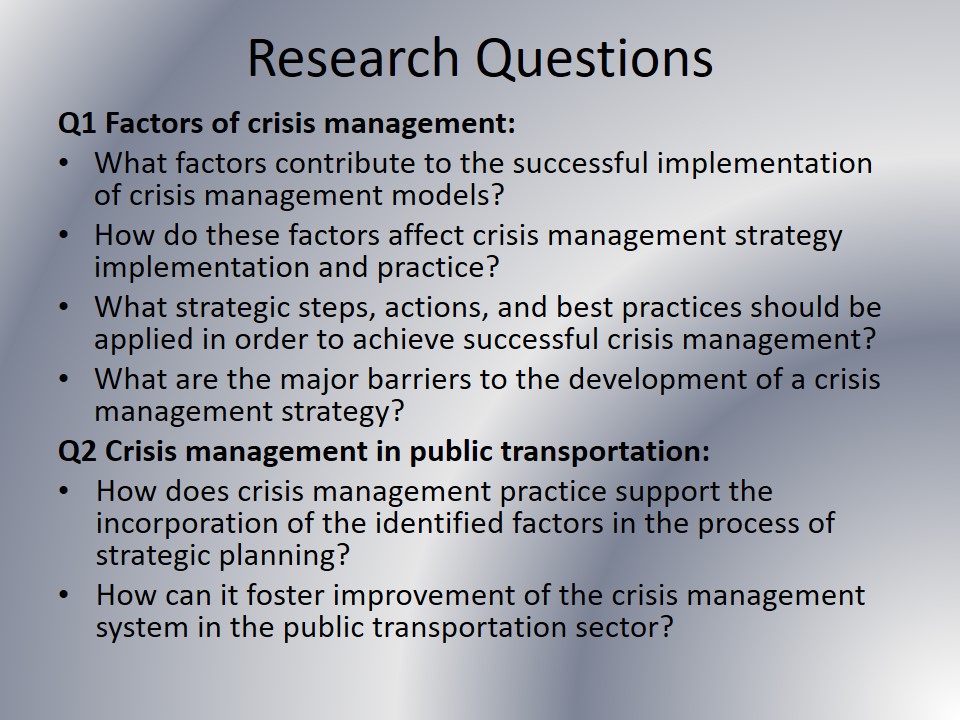
Literature Review
Crisis Management
- Crises occurring in public transportation can be characterized in the following ways:
- Related to the transport system, an organization, or a company.
- Linked to the transport infrastructure.
- Associated with internal and external human factors.
- Linked to the rolling stock.
- Numerous studies emphasize the importance of coordinating access to information with support actions in the crisis management framework:
- For instance, Yin and Jing (2014) suggest using various technologies, e.g., geographic information systems, as managerial tools and combining them with the Internet for mobilization.
- This approach facilitates the information sharing needed for successful crisis response.
- Some studies approach crisis management by utilizing the principles of complexity and chaos theory:
- An efficient crisis response is regarded by Paraskevas (2006) as a co-evolving living system.
- “The system is able to learn from its environment and change its internal structure and organisation over time, thus changing the behaviour of individual elements” (Paraskevas, 2006, p. 893).
- The relationships within complex systems are nonlinear and therefore are associated with an extreme level of uncertainty and unpredictability.
- The process of adopting complexity principles may include:
- Identification of alleged problems.
- Formulation of objectives that go beyond the management culture and modify the efficacy of routine daily activities.
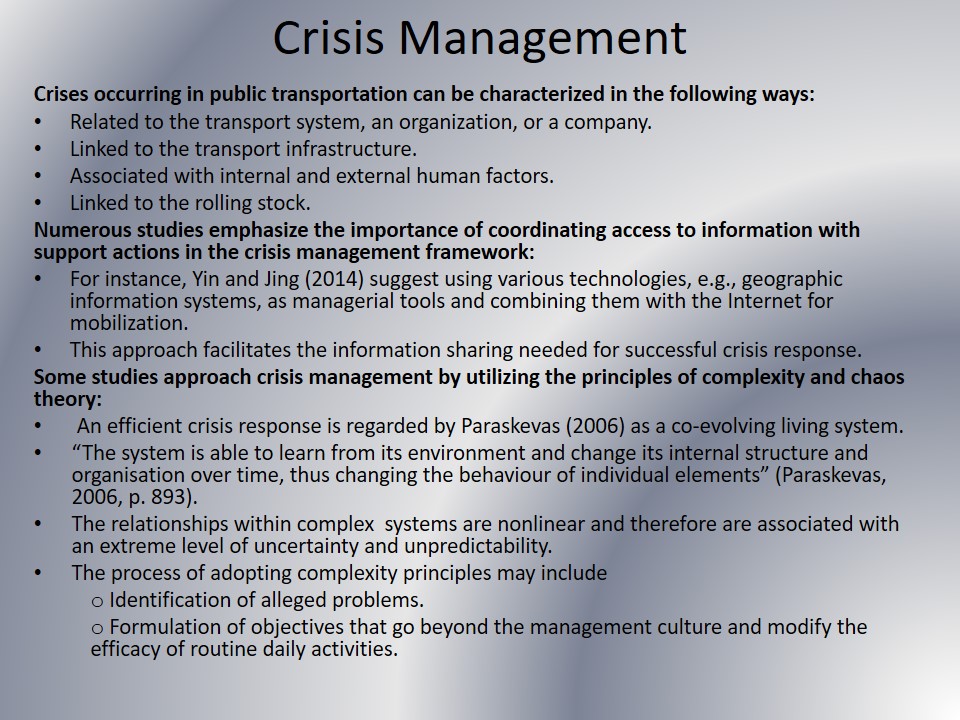
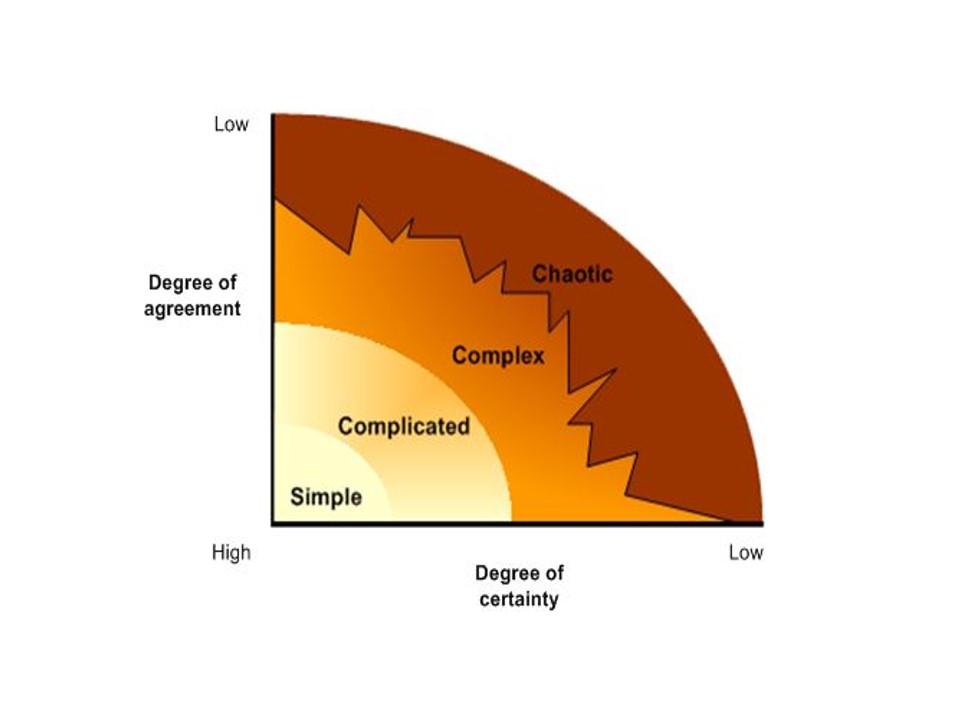
Theoretical Frameworks
Performativity is the key concept that helps understand how efforts in crisis response can be coordinated.
- The concept of performativity mainly refers to practices that involve correspondence.
- Pramanik, Ekman, Hassel, and Tehler (2015) see performativity as an idea that guides postponed activities in view of streamlined data in which involved parties can attempt to engage in mutual sense-making, i.e., interpreting cues and situations and transforming them into words and actions.
- During sense-making, crisis responders translate their experiences into words, labels, and frames. In doing so, some communication hints may remain unnoticed.
- Conversely, performance refers to an open collaboration built on ongoing interactions and actions.
- Performativity defines communication between stakeholders as both an action and a sense.
- The theoretical framework suggests that each performance is transformative, i.e., performers may continuously subvert and create new meanings instead of sticking to one sense ─ this process can negatively affect coordination.
- Performativity plays a significant role in the management of power flow and allocation of responsibility in reaction to crisis, as well as stakeholder involvement.
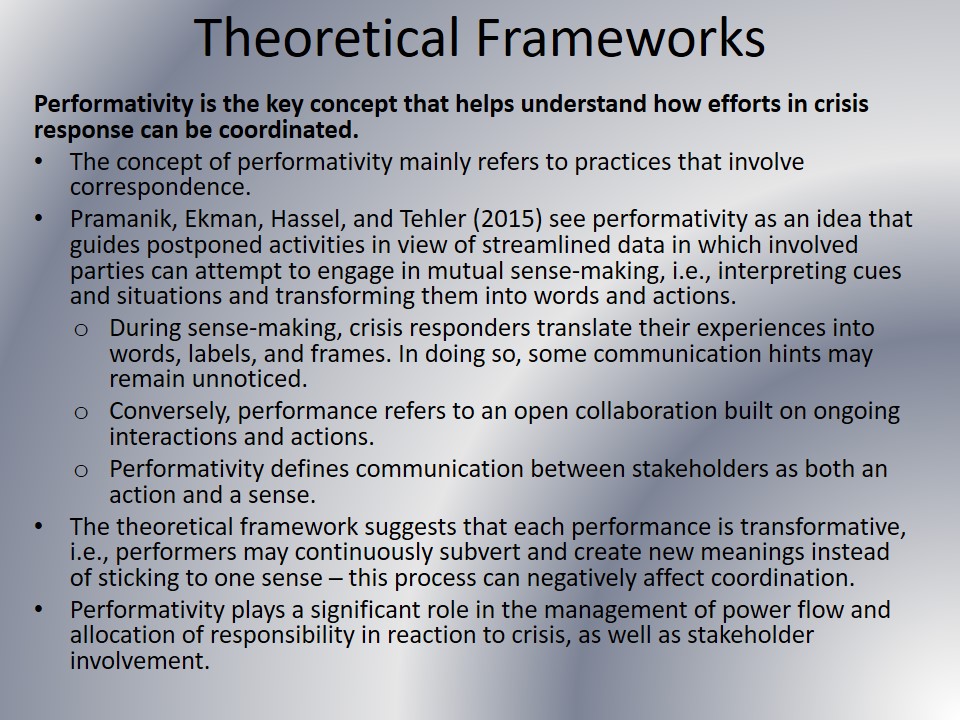
Stakeholder Participation/Involvement
- In the study, stakeholders’ personalities and interests are represented as exogenous factors.
- Stakeholders are as significant for the organization as power, authenticity, and criticalness, yet they are not always considered in crisis response administration (Pramanik et al., 2015).
- The stance and attitudes of stakeholders are not static and can be drastically changed depending on the choices made by the administration during a crisis (Pramanik et al., 2015).
- The unforeseen and dynamic nature of stakeholders’ characters, interests, and positions may affect the administration’s decision-making.
- Persuasive stakeholders, especially if they comprise a large part of the population, require consideration in the process of crisis management (Acquier, Gand, & Szpirglas, 2008).
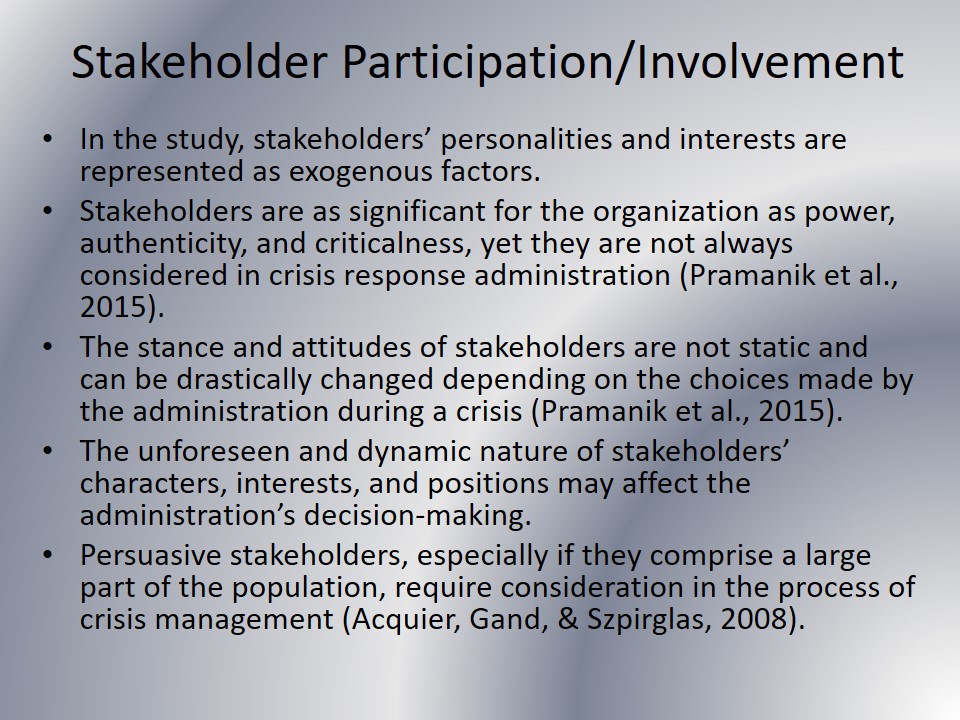
Power Dynamics
- Capacity for governance is often associated with power dynamics within an organization.
- Power dynamics are an equivalent of state infrastructural control (Ponis & Koronis, 2012).
- Power dynamics are defined by the connection between government experts and the local community (Kleiboer, 1997).
- Governance capacity depends on the association’s level of social support, i.e., the way individuals perceive the government and act towards it (Ponis & Koronis, 2012).
Researchers distinguish four managerial limits related to the capacity for governance:
- Coordination limit ─ uniting different associations to lock in joint ventures.
- Diagnostic limit ─ investigating data and appraisals.
- Direction limit ─ control, observation, oversight, and evaluation.
- Conveyance limit ─ taking care of the crisis, establishing control measures, and open administration and communication, in particular.
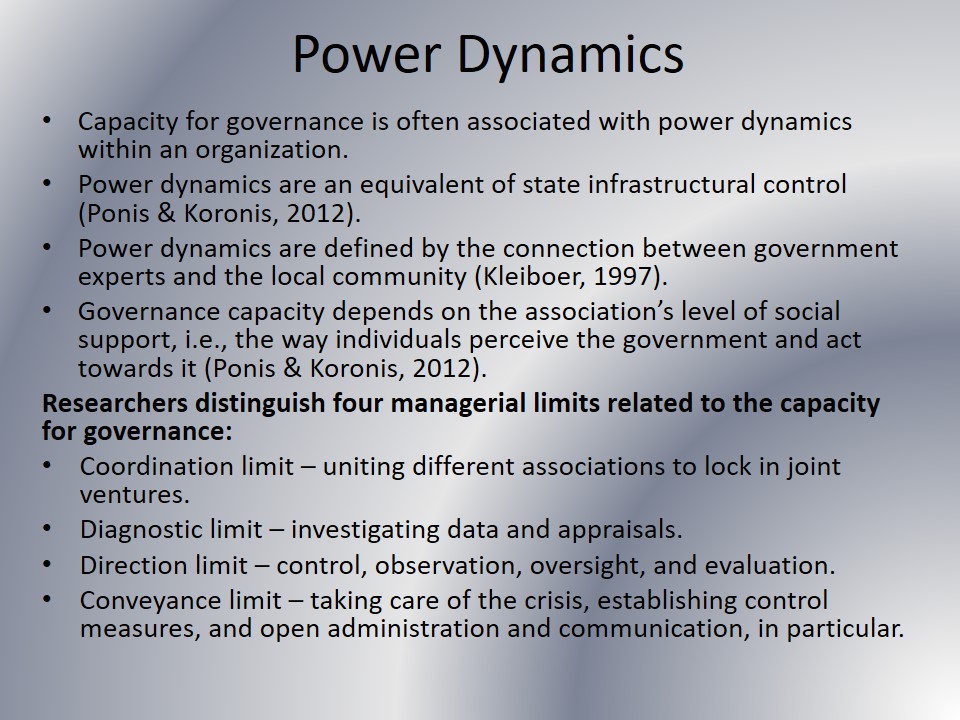
Information Transmission
Since crisis management implies the coordination of activities by different groups and stakeholders, the efficacy of communication and information transmission between them is of great significance.
- Mapping techniques can benefit associations in comprehending the crisis circumstances and building a compelling crisis management design.
- A schematic approach to the evaluation of crisis risks is required to connect current goals and subjective methodologies while the crisis is being characterized.
Complete interoperability and perfect message exchange among crisis response actors is hard to achieve if there is no unified information transmission infrastructure among different parties involved, and if they use different devices and software programs.
Various organizational levels and elements of operation must be considered during crisis evaluation and information transmission:
- Human procedures, including correspondence, leadership, etc.
- Organizational structure and technology.
- HR management practices.
- Strategic management techniques and components.
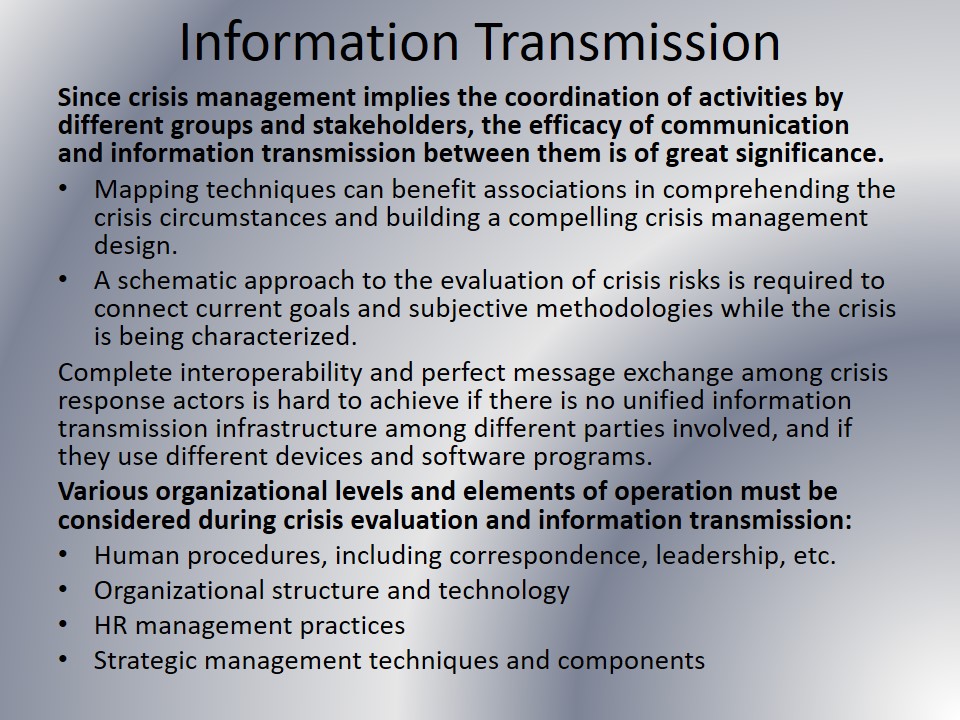
Hypotheses
Based on the findings of the preliminary literature review, the following hypotheses are proposed:
- The relationship with stakeholders is positively correlated with crisis management efforts.
- The power dynamics within an organization are positively correlated with crisis management efforts.
- A well-developed information transmission system within an organization is positively correlated with crisis management efforts.

Framework Development
- The factors of capacity for governance, information transmission, and stakeholder relations continuously interact with each other.
- Based on the given assumptions, the following framework that might support organizational crisis management efforts is suggested:
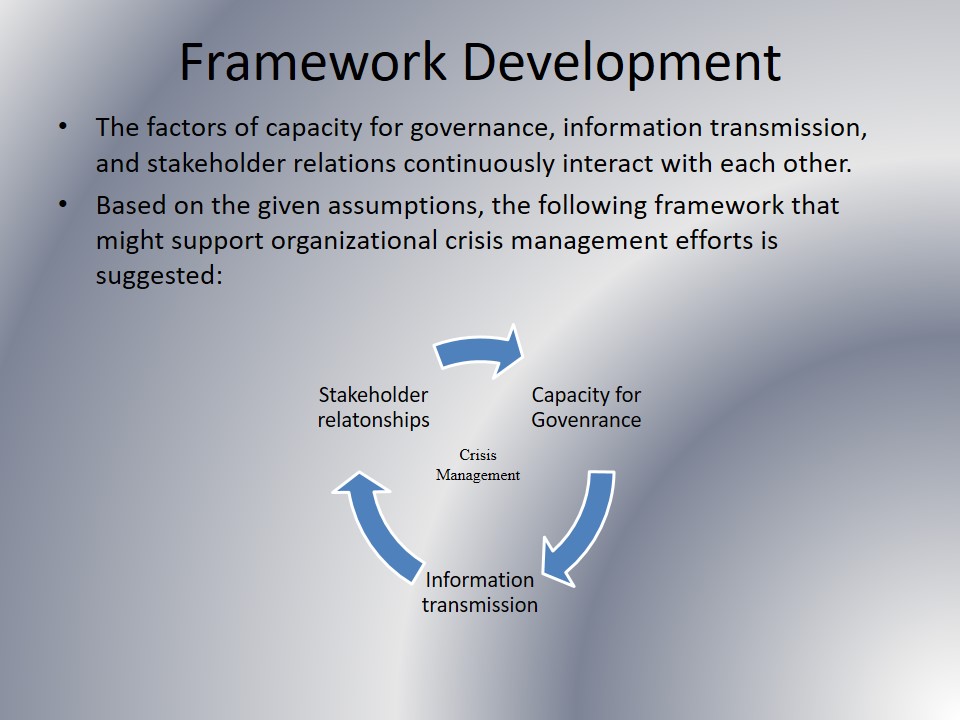
Methodology
- A quantitative research design will be employed to answer the formulated questions and verify the hypotheses.
- Quantitative methods include numerical calculations, estimations, and statistics.
- The given framework suggests that an objective truth about a particular process of interest can be revealed, and this truth can be measured and scientifically explained by using various quantitative methods that allow researchers to detect cause-and-effect relationships between the studied variables and to generalize the findings (Creswell, 2009).
- Quantitative research is deductive ─ data collection and analysis processes aim to verify the preliminary formulated hypotheses.
- The methodology is associated with a low chance for data biasing.
- Research Methods:
- Setting: Dubai’s RTA.
- Sample: 50 randomly selected RTA managers and decision makers.
- Data collection tools: survey and questionnaire.
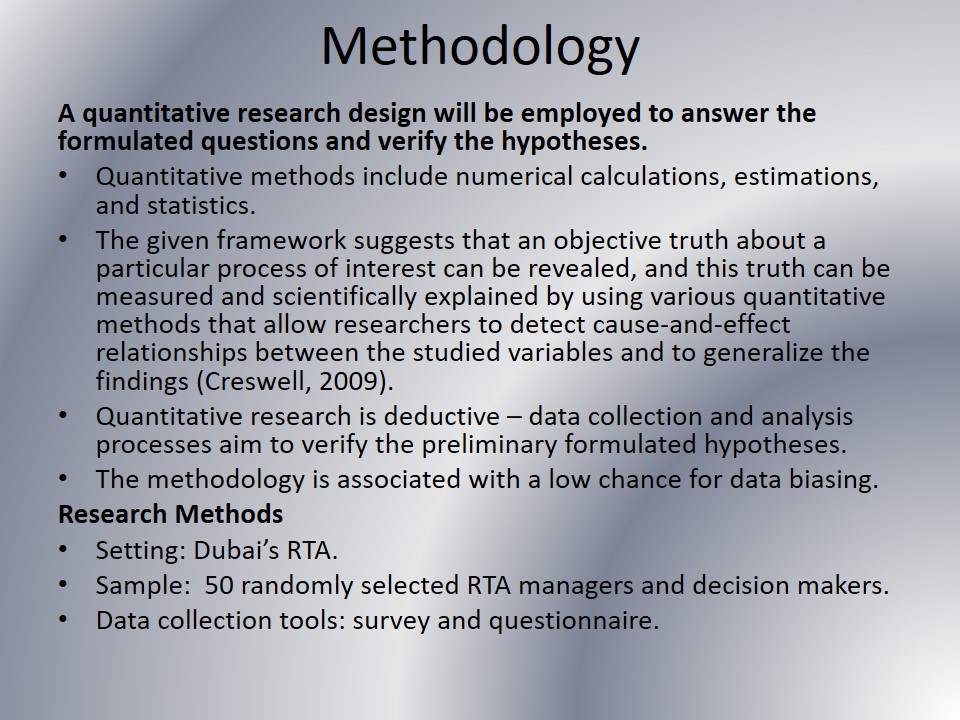
Ethical Considerations
Research ethics are meant to help scholars to avoid harm to study participants and comply with all regulations and standards that protect individuals and the public well-being.
- Benefits: researchers must reduce the possibility of harm and negative influences on study participants, not only concerning their physical well-being but also their psychological state and social identity as well.
- Confidentiality: the process of protecting the privacy of study participants; non-violation of their control over the extent and circumstances of sharing personal information.
- Informed consent: researchers must respect participants’ autonomy and decisions.
- Researchers are expected to give a sufficient amount of information to respondents so that they will be able to make an informed, voluntary decision.
- Research integrity: researchers are required to be objective while conducting the study, which can be achieved by avoiding prejudice, opinionated views, and personal biases.
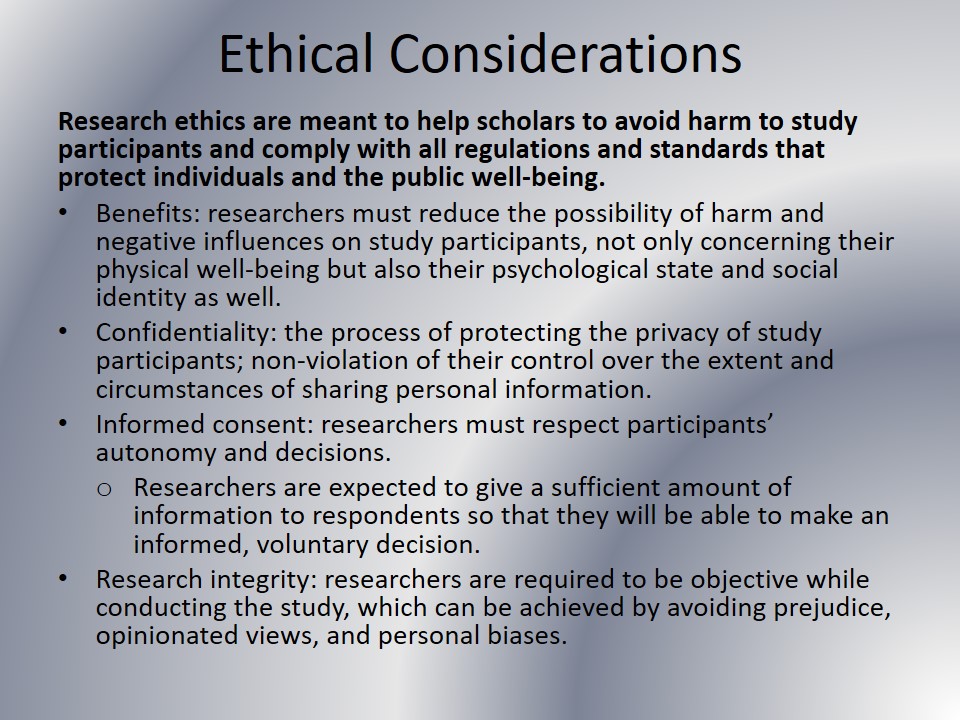
Conclusion
- The study findings are expected to deepen the understanding of how various factors may influence crisis response activities in the context of strategic management.
- The research will be able to contribute to current theories and discourses by providing new evidence that may fill gaps in knowledge about crisis management in the public transportation industry.
- The research will contribute to managerial practice by offering a framework according to which public transportation officials will be able to navigate their decisions and actions in order to facilitate crisis management efforts.
- The following views will be taken into account during the examination of data:
- The issues and situations to be navigated through crisis management.
- The perceptions of the role of the identified critical factors in crisis management within the public transportation sector.
- The opinions of the study participants on whether these factors require some modifications within the selected setting.
- The importance placed on changes in the structure, protocols, and strategies as a means to facilitate the management process.
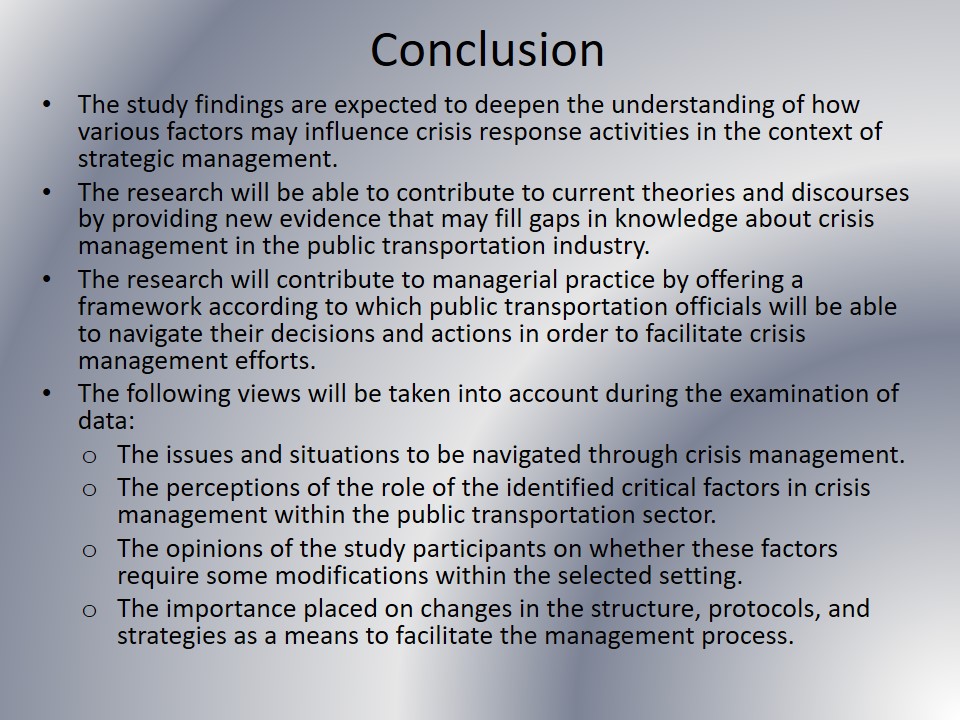
References
Acquier, A., Gand, S., & Szpirglas, M. (2008). From stakeholder to stakeholder management in crisis episodes: A case study in a public transportation company. Journal of Contingencies and Crisis Management, 16(2), 101-114.
Creswell, J. (2009). Research design: Qualitative, quantitative, and mixed methods approaches. London, UK: Sage Publications.
Kleiboer, M. (1997). Simulation methodology for crisis management support. Journal of Contingencies and Crisis Management, 5(4), 198-206.
Paraskevas, A. (2006). Crisis management or crisis response system? A complexity science approach to organizational crises. Management Decision, 44(7), 892-907.
Ponis, S. T., & Koronis, E. (2012). A knowledge management process‐based approach to support corporate crisis management. Knowledge and Process Management, 19(3), 148-159.
Pramanik, R., Ekman, O., Hassel, H., & Tehler, H. (2015). Organizational adaptation in multi‐stakeholder crisis response: An experimental study. Journal of Contingencies and Crisis Management, 23(4), 234-245.
Stein, J. G. (2008). Crisis management: Looking back to look forward. Political Psychology, 29(4), 553-569.
Yin, S., & Jing, R. (2014). A schematic view of crisis threat assessment. Journal of Contingencies and Crisis Management, 22(2), 97-107.